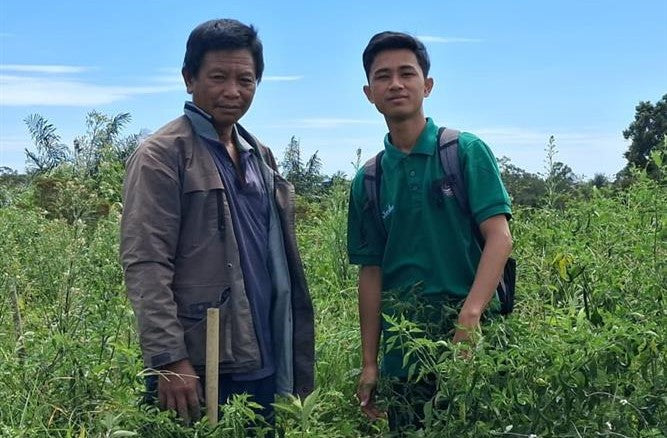The volatility of the Sumatran coffee price over the last 10 years is one of the key factors impacting the current and future nature of Simalungun farming practice. Local farmers have been on an ongoing quest to find the crop that can deliver the best financial return for their patch of land. For several years, what was once a strong coffee-growing region had instead turned to citrus, with low coffee prices sadly forcing farmers to seek alternative means simply to ensure their survival.
However, when we returned to the region in late 2023, coffee trees has made a return to the landscape, their branches once again reaching into the clouds. Higher coffee prices had inspired farmers to once again invest their time and effort in coffee, with genuine hope for a good return.

But there was a problem.
It was distilled down for us in one particular meeting we had with an established coffee farmer, whose family owned a large plot of land that was now full of healthy coffee trees, ostensibly in their prime. But there were as yet few red cherries dotting their branches. And he was frustrated.
"Why aren't my trees producing any fruit yet? They should be by now, if not last year."
The trees had grown. They had been tended with care but the expected yield had not eventuated. Unfortunately, the farmer's frustration was far from isolated. We stumbled upon many local farmers with the same problem. If our Tiga Raja mill was to once again hum happily as it processed those beautiful Simalungun cherries, we realised we would need to find a way to help these farmers make their harvest a bountiful one.
Enter: Science.
It dawned on us that the crop rotations of recent years and changing climate conditions had likely the landscape, both literally and figuratively. And so, the best way forward would be to engage experts who could use their knowledge to understand the unique agricultural challenges faced by local farmers and use evidence-based scientific techniques to counter them.
Consequently, in an area where quantity had once been the primary driver of financial return, the success of local farmers was now to be contingent on the quality of their seedlings, based upon the identification of those varieties most suited to this particular region.
And so, the Tiga Raja Improvement Plan was born.

Working with our café partner, Flo Espresso who raised funding to help run this project alongside Five Senses Coffee, we devised a range of measures designed to assist local farmers in numerous ways:
1. Investing in High Quality Seedlings
We reached out to an Agronomist to help us identify and source 30,000 high quality seedlings that suit the local microclimate and terroir; these are on track to be distributed to local farmers across 2024 and 2025. These will primarily go to our list of active farmer members who are eager to commit on both quality, as well as sustainable coffee farming practices. The first small batch of 5000 seedlings was distributed in December 2024 to about 50 farmers. It was a life-changing experience, witnessing a new hope in their eyes as they held those little coffee trees in their hands. We are planning to distribute another 5000 seedlings across the next couple of months, and 20,000 seedlings in December in 2025.

2. Hiring a Graduate Agronomist to Support Local Farmers
Local support from a qualified agronomist will be key to the success of the program. We want to get things right from the beginning; we understand that planting a crop is an investment that comes with significant risk for our farmers too. To reduce that risk and provide expert support, our agronomist is working with farmers directly, verifying our current members for our next seedling distribution, ensuring they have suitable land available for planting, along with requisite level of soil preparation. We aim to build a strong community of farmers where best practice at every level of coffee farming is both understood, practiced, and shared.
3. Establishing a Model Farm at the Mill
This knowledge sharing will be embodied and facilitated in a workshop and model farm at the mill, which will be accessible for coffee farmers. It will be a place to learn and share practical questions, experiment with processing types, and better understand and contextualise their own personal farming experiences. With the help of our resident agronomist, we envision it will become a 'hub' for best practice coffee farming; a model farm to showcase ideal tree spacing for optimal growth and yield; how to best enhance soil quality through appropriate treatment and fertilising; and demonstrations of effective farming techniques to maximise coffee production while ensuring sustainability.

Through the Tiga Raja Improvement Plan, we aim to ensure farmers will receive the necessary support that helps them best adapt to their magnificent, but challenging (and changing) environment. We want to assist them in improving their livelihoods by increasing their return in both coffee yield and coffee quality. With ongoing investment in education, tools and practical farming models, this initiative aims to ensure that not only we can all continue to enjoy the beautiful coffee unique to this part of the world, but ultimately create a more sustainable and prosperous future for the region's wonderful, resilient and proud coffee growing community.



